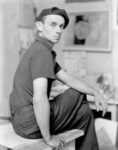
Ben Nicholson
British, 1894-1982
Topaze, 1951
oil and pencil on canvas
38 ½ x 49 in.
SBMA, Bequest of Suzette Morton Davidson
2002.31.3

In a carefully posed portrait by Paul Laib from c.1933 (fig. 2), Nicholson presents as an unsmiling figure, wearing black with a beret. Turning athletically to challenge the viewer, he does not seem English, but rather, conveys the air of a revolutionary, artist or intellectual of the Parisian Left Bank. - RAISING THE FLAG OF MODERNISM: BEN NICHOLSON’S 1938, Sophie Matthiesson
“Realism’ has been abandoned in the search for reality: the “principal objective” of abstract art is precisely this reality.”
- Ben Nicholson
COMMENTS
Ben Nicholson was a British painter and maker of reliefs, and one of his country's most distinguished pioneers of abstract art. From his father, Sir William Nicholson, he inherited a feeling for simple and fastidious still lifes, which with landscapes made up the bulk of his early work. In 1921, on a visit to Paris, he first saw Cubist paintings and in the following years his still lifes showed a personal response to the standard Cubist repertoire of objects such as jugs and glasses, which he arranged as flat shapes on the picture plane.
Nicholson was also influenced by the naive painter Alfred Wallis, whose work he discovered in 1928 and whose roughly textured surfaces he emulated. From the early 1930s he turned to abstraction, partly because of the influence of Barbara Hepworth (they shared a studio from 1932 and married in 1938) and partly because of the impact of several visits he made to Paris at this time. He joined the Abstraction-Création association in 1933 and became friendly with several leading avant-garde artists, Mondrian's work in particular coming as a revelation to him. In 1933 he made his first abstract relief and in 1934 his first strictly geometrical ‘white relief’ in painted wood, using only straight lines and circles. Such works were the most uncompromising examples of abstract art made by a British artist up to that date (White Relief, 1935, Tate, London). He also did paintings in a similar intellectual vein but with a poetic refinement of colour that offsets their severity of composition (Painting, 1937, Tate). By this time Nicholson was recognized as being at the forefront of the modern movement in England. He was a member of Unit One (1933), and one of the editors of Circle (1937). In 1939 he and Hepworth moved to Cornwall, where they became the nucleus of the St Ives School. They divorced in 1951 and in 1958 Nicholson settled in Switzerland with his third wife, the Swiss photographer Felicitas Vogler. After the Second World War he won an international reputation, accompanied by many awards. He returned to England in 1971. His late work moved freely between abstraction and figuration and included large, free-standing reliefs, notably one in marble in the garden of Sutton Place, Surrey (1982). Nicholson's first wife, Winifred Nicholson (1893–1981), was a painter of distinction. She is best known for her flower paintings, but she also did other subjects and abstracts, all her work showing her joy in colour and light.
- The Oxford Dictionary of Art and Artists (Oxford University Press)
SBMA CURATORIAL LABELS
Ben Nicholson started painting under the influence of his father Sir William Nicholson, a master manipulator of paint, whose hallmark was the luscious tactility of the material. It was not until he met and married Winifred Roberts in 1920 that he became familiar with the work of Cézanne and started experimenting with more advanced techniques. He co-founded a radical exhibiting group, the Seven and Five Society (seven painters and five sculptors), which he eventually destroyed in the mid 30s by his insistence that only non-figurative work could be exhibited. The Dutch refugee, Piet Mondrian, became a friend and neighbor during his time in London, and Nicholson became the leading practitioner in Britain of geometric abstraction, though he never relinquished his interest in architecture, landscape and still-life as a trigger for his work.
- British Modernism from Whistler to WWII, 2016
